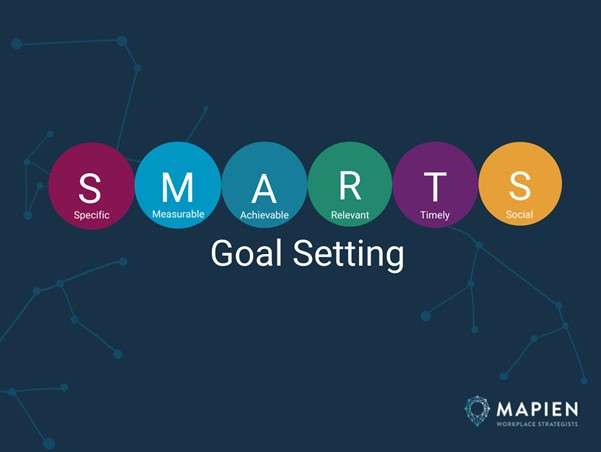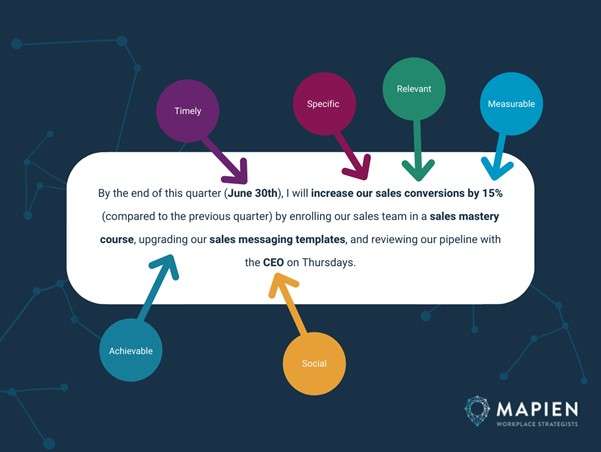
Using SMART(S) Goals In Leadership, Coaching, and Mentoring
This is blog #8 in our series on coaching models. Sign up to our mailing list to make sure you don’t miss out on our future content.
You wouldn’t throw a coin in a fountain and wish you’d magically meet your quarterly KPIs, would you? But we’ve all heard the saying… a goal without a plan is just a wish!
The fact is, in order to make your goals happen, you need to set clear intentions and create a plan you can actually follow through on. Many leaders use the SMART framework to develop their own goals in the workplace, or to coach and mentor teams through goal setting.
We’re huge fans of this method, too — but it’s worth taking a look at its origins, the research behind it, and how you can improve on the SMART method with new criteria to make it even more practical for setting and achieving goals.
Origins of the Smart Goals
SMART goals have been around since 1981 when consultant and management expert George Doran introduced the concept in an article, “There’s a S.M.A.R.T. way to write management goals and objectives”.
The main idea behind SMART is to outline five key criteria for writing and structuring goals in a more practical way: Specific, Measurable, Achievable, Relevant, and Timely.
More than four decades later, SMART goal setting remains a hugely popular method used in a variety of fields, including business, management, education, and professional development.
SMART Goals: What the Research Says

The SMART goal setting technique has been studied by a number of researchers over the years.
For example, one study found that this approach to setting goals at work led to more flow, lower stress, higher engagement, and better performance. Meanwhile, another study found that students that were required to use SMART goals early in the semester improved their learning outcomes.
Other researchers have looked at the specific criteria behind goal setting. For instance:
- This research paper examined how goals influence performance, finding that a specific goal caused individuals to plan and organise more than a general goal.
- This research showed that quantification (i.e. turning goals into measurable data) can promote goal pursuit motivation, and being able to track progress on a goal can increase self-empowerment.
- Another study looked at students who were learning a language and found that setting achievable goals made both teaching and learning more effective, as this kept learners motivated for task performance.
- In this study, motivation to continue pursuing a goal is also impacted by the amount of time remaining, where a goal is time-bound.
- Relevance is another important factor for goal-setting success, with studies finding that task performance is a function of goal level, self-focus, and perceived goal importance.
Overall, research confirms that the combination of SMART criteria can help people realise the level of self-efficacy and motivation needed to achieve their desired outcomes. That said, newer research also suggests that it may be possible to expand on the original model and improve it…
Social Boosting: The Missing SMART Criteria

Recently, we’ve seen an increase in performance research that emphasises the importance of social boosting. This comes from building in various points of accountability throughout the duration of the goal.
The following examples of research support the benefits of accountability in goal setting:
- This paper found that accountability during the goal pursuit process was positively related to performance improvement in a complex decision-making task.
- This article argues that social and personal methods of pursuing goals can work together to improve goal pursuit, with individuals frequently achieving goals by relying on others.
- This research found that accountability (in the form of weekly progress reports) had a positive effect, with participants accomplishing significantly more than others.
- This literature review discusses findings that employees with greater personal accountability perform at a higher level than those that do not.
- The results of this research indicated that the social and motivational factors of participation in goal setting increased performance, goal acceptance, group commitment, incidental learning, and satisfaction.
Based on these findings, there appears to be growing value in incorporating a second “S” to represent the Social element of effective goal setting. As such, we propose updating the model to SMART(S) to cover all six criteria points.
How Leaders, Coaches, and Mentors Can Apply SMART(S)

As a leader, you need to be confident enough with the SMART(S) goal setting framework to develop your own goals, and to guide others through the process. Although SMART(S) goals aren’t necessarily difficult to develop, it’s worth becoming more familiar with the model so that you can provide feedback and prompt others if they get stuck.
We’ve broken down each of the criteria below, along with examples and prompts to help define and refine your goals.
Specific – Simple, Succinct & Focused
Example: Increase sales conversions
Consider your broader goal and what you want to achieve — for the above example, our broader goal is to increase sales. Now start to refine this goal into something more specific. Useful prompts for getting specific include:
- What exactly do you want to accomplish?
- How do you see yourself achieving your broader goal?
- Who, if anyone, needs to be involved?
- What is the reason, purpose, or benefit behind accomplishing your objective?
Measurable – Track Your Progress
Example: Increase sales conversions by 15% (compared to the previous quarter)
Expand on your stated goal with detail on how you’ll track your progress or determine your success. Useful prompts to help make your goal measurable include:
- How will you know you’ve reached your goal?
- What will indicate you’ve made progress?
- How can you quantify your achievement?
- What data or feedback will help you track your progress or success?
Achievable – Skills, Will & Resources
Example: By enrolling our sales team in a sales mastery course, upgrading our sales messaging templates
Add more details to your goal, breaking it down into practical actions and steps that you can realistically accomplish. Some useful prompts for this criteria include:
- How will you upskill or build the necessary capabilities?
- What resources will you need?
- Is it realistic to take these steps within the time and budget you have available?
- Is the amount of required effort reasonable, considering what the goal may achieve?
Relevant – Important & Meaningful
Example: Sales conversions
Review your current work-in-progress through the lens of relevance. There’s no point in going any further unless your goal is important and meaningful to you, your work, and/or your team. Useful prompts for considering relevance include:
- Is it worthwhile?
- Is this the right time?
- Does this align with our other efforts?
Timely – Set Deadlines & Milestones
Example: By the end of this quarter (June 30th)
Incorporate timing into your goal to give yourself a deadline to achieve it by, or checkpoints for specific outcomes. Some prompts to help determine timing include:
- When will you achieve the objective?
- When do you expect to see some short-term outcomes?
- What timing is realistic but challenging?
- How might this timing impact your other projects?
Social – Involve others for Accountability
Example: Reviewing our pipeline with the CEO on Thursdays
Finally, incorporate a social element to help you be accountable to others, and increase the likelihood that you follow through on your commitment. Some prompts to help shape your social element include:
- Who else will be involved in the process?
- Who is best positioned to keep you accountable?
- When and how will they be involved?
Discover More Leadership & Coaching Resources
Enjoyed learning about SMART(S) goal setting and looking for more leadership and coaching resources? We’ll be back soon with more coaching models in this series, or you might be interested in checking out some of our previous models, such as the GROW Coaching Model, the Situational Leadership Model, the Stages of Change Model, and Understanding Stealth Expectations.
Or you’re welcome to drop us a line if you’d like help implementing a coaching and mentorship program in your workplace.

